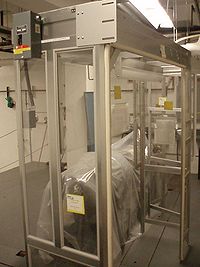CLAS12 R1 Progress Reports
The Drift Chamber Wiki at JLab
9/2/09
An array of temperature probes will be used to monitor the ISU clean room's temperature and humidity, with one probe being a temperature and humidity probe.
Five probes will be used for basic temperature monitoring. These probes are the Sensatronics's Standard Temperature Probe and will cost $60.50 each.
ISU already possesses the Sensatronics's Temperature-Humidity Combo Probe which will be used to monitor the temperature and humidity in the center of the room.
The thermometer's analog output is converted to a digital signal using the Sensatronics Model EM1 Environmental Monitor. This device supports up to 12 monitoring probes and has a built-in web server to transmit its data over the network upon request. This device will cost $438.90.
The total cost will be approximately $760.00 for temperature monitoring in the ISU clean room. The temperature probes will allow for real time temperature monitoring with web access to the data. This data will be plotted using the same system as the BREMS cluster located at ISU.
12/3/09
Clean Room entry doors
These are the entryway doors donated by ON semiconductor for the ISU clean room. They will be fitted together to form an air shower device for entering the clean room.
Temperature Monitoring
Continuous temperature and humidity monitoring has been performed in the ISU clean room for the past month.
The data so far show a 2 degree Fahrenheit temperature deviation in the clean room. These fluctuations are within the accepted fluctuation deviation required for the construction of the R1 drift chambers.
The humidity has been fluctuated more than the temperature, but has remained consistently well below the 55% requirement.
R2 Stringing Platform
File:StringingPlatform 12-3-09.pdf
Here is the design sent to ISU of the R2 stringing platform. It is currently believed that it should fit in the ISU clean room for the purpose of stringing the R1 wire chambers.
12/9/09
Received pdf schematics of the R2 Stringing platform. It appears that it will be able to fit in the ISU clean room without a problem. If the size could be reduced without sacrificing functionality, that would still be beneficial.
File:StringingPlatform 12-9-09.pdf
Temp fluctuations in the Clean room appear to be +/- 6 degrees F. There are no fans in the room yet to circulate air and the thermostat has not be set to minimize temperature fluctuations. The air temperature outside the building has fluctuated from 60 to -12 degrees F.
03/18/10
So far for the clean room construction floor and design plans are almost finalized and will be posted by next Thursday (03/25/2010) and are not up this week due to a software problem cause from an Operation System Upgrade.
These designs will be similar to what has been previously posted.
As for temperature control, the graphs can be found here. As can be seen, the temperature has been roughly constant with only slight perturbations until the last couple of days. This increase in temperature is probably due to the increase of temperature here in Pocatello.
While within the accepted deviations, work will be done to ensure less fluctuations in temperature by working with Facility Services to get better temperature detection in the room. Also, when the room is actually constructed, the walls should help prevent heat loss or gain inside the cleanroom environment to a greater degree.
Materials and Supplies
To construct the cleanroom at the ISU facility will require:
~1300 feet of Unistrut - ~$7,600.00 (This includes all the bolting material also) ~135 Ceiling Panels - ~$3,200.00 13 HEPA Filters - ~$9,400.00 (We are currently talking with ON Semiconductor for a possible donation of HEPA Filters) 74 Lights - ~$7,000.00 Particle Counters Paint (non-leaching) Furniture Curtains - ~$5,800.00 Doors - ~$ 900.00
The list of further equipment needed with their estimated costs will be uploaded as soon as the information becomes available.
Construction of the ISU cleanroom is anticipated to start near the beginning of May 2010 and will employ 1 graduate student to supervise and help with the construction. Several REU students that are coming to ISU, plus some upper division high school interns. Construction will be under full swing from May 2010 with anticipated completion by August 2010.
Testing will then ensue to ensure that the cleanroom does meet ISO 10,000 standards.
6/10/2010
1.) Wire tension apparatus
A new technique is being developed for measuring the wire tension. The wire is pinged every second. The wire resonance is measured by a scope. The scope does a FFT of the response. Short wires are at a fast frequency but weak. This requires sampling over many pings as the signal dies off quickly. LOng wires vibrate so slowly that it is hard to measures the frequency. Perhaps sampling the long wires over 1 ping is a better improvement. Chris quevas has measured this and is not finding too much difference between using 1 or several pings. Measurements take about 1 minute or less per wire. THe goal is to measure 10 wires per minute as was done using the old technique. The new technique is Labview friendly but it hasn't been implemented. Right now the FFT is output to a text file.
2.) Endplate Nomenclature
icol = column of 11 wires , lower col number is closer to the endplate
irow = row of wires smaller row number is closer to the target
ilayer = enplate identification, the guard wire that is closest to the target (22 layers)
iwire = wire number within the icol, irow, ilayer (114 wires)
irow:3, 10, 226 col with 11 = 2490 wires in a chambers except for R2
